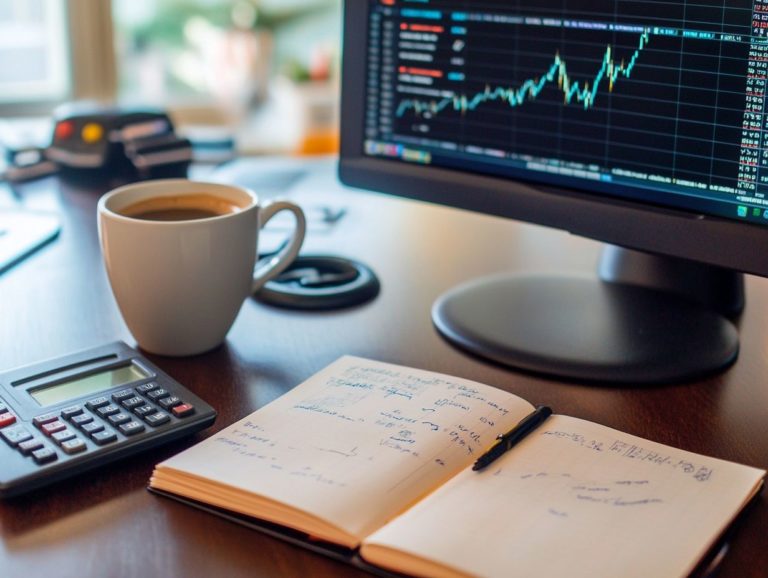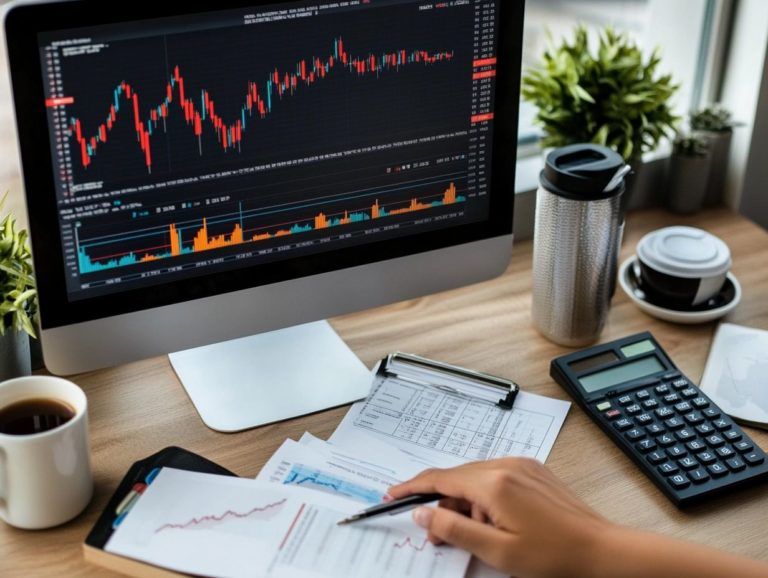How to Develop Your Own Trading System
In the world of trading, a well-structured system can be the key to success or failure.
This article covers the essentials of trading systems. You’ll learn what they are and the benefits of creating your own.
You will discover tips for maintaining and improving your approach in a changing market. Get ready to supercharge your trading skills!
Contents
Key Takeaways:

Understanding the Basics of Trading Systems
Understanding trading systems is essential for anyone looking to succeed in financial markets. A trading system is a structured approach that combines market analysis, risk management, and emotional discipline.
This method helps you navigate various trading styles, including position trading, swing trading, and day trading. A solid trading plan sets clear goals and reduces emotional decision-making.
What is a Trading System?
A trading system is your method for making informed decisions based on data and set rules. It includes trading strategies that guide when to enter or exit trades.
Trading indicators are crucial to your decision-making. They range from moving averages to momentum indicators, helping you assess the market and predict price movements.
A systematic approach ensures your trades follow established guidelines rather than emotions. This method sharpens your focus and helps you achieve your trading goals.
Benefits of Having Your Own System
Your own trading system builds discipline and limits emotional trading decisions that can lead to mistakes. Specific strategies help you navigate the market with confidence.
A personalized trading plan promotes consistency and improves risk management by defining entry and exit points based on research.
Following set stop-loss orders can reduce panic during downturns and protect your capital. This structure boosts performance and fosters accountability.
Factors to Consider When Developing a Trading System
When developing a trading system, consider critical factors like thorough market analysis and effective risk management.
Ensure your trading goals align with your available trading capital. This approach will set you up for a more successful trading experience.
Market Analysis

Market analysis helps you evaluate financial markets. You can find profitable trading opportunities and trends to refine your strategy.
This process uses various techniques to enhance decision-making, particularly through fundamental and technical analysis. With fundamental analysis, you assess economic indicators, company earnings, and market news to determine the intrinsic value of assets.
On the other hand, technical analysis dives into historical price movements and patterns. It leverages charts and indicators to forecast future behavior. By skillfully combining these methods, you ll be adept at recognizing market trends whether they re bullish or bearish.
Identifying patterns such as head and shoulders or double tops is crucial. This skill helps you make better trades that align with your investment objectives, optimizing your potential for success.
Risk Management
Risk management is an essential pillar of any trading system. It ensures that you protect your capital while maximizing potential returns through the strategic use of stop-loss orders (automatic sell orders to limit losses) and an optimal risk-reward ratio (the ratio of potential profit to potential loss on a trade).
By implementing these tools, you can navigate market volatility more easily, effectively shielding your investments from unexpected downturns.
Learning to calculate risk-reward ratios can boost your confidence in trading! Neglecting proper risk management can lead to significant financial setbacks, ultimately undermining your overall performance and confidence.
It s crucial for anyone trading to adopt sound practices that prioritize capital preservation while fostering growth.
Trading Style and Goals
Choosing the right trading style is key to achieving your goals. Whether you prefer position trading, swing trading, or day trading, understanding each style can boost your success.
For example, position trading may be ideal if you re comfortable holding trades for weeks or months, focusing on long-term trends and fundamentals. Swing trading might appeal to your desire to capitalize on short-term price movements over several days or weeks.
If you thrive in fast-paced environments and enjoy making quick decisions, day trading could be your perfect match. This style involves executing multiple trades within a single day.
Ultimately, your choice should reflect your personal preferences, risk tolerance, and the amount of time you can devote to trading. This ensures that your strategy integrates seamlessly into your lifestyle.
Steps to Developing Your Own Trading System
Developing your own trading system requires a systematic approach. Begin by clearly defining your trading strategy, and then progress to how to develop a technical analysis strategy to refine its effectiveness and enhance your trading performance.
This systematic process sharpens your skills and sets you up for immediate success in trading!
Define Your Trading Strategy
Defining your trading strategy is essential. It sets the stage for your trading objectives and informs your approach based on the market context and trading indicators.
By identifying specific goals whether it s desired profit margins or your risk tolerance levels you can tailor your strategy to align with your personal financial aspirations.
The selection of relevant trading indicators, like moving averages or RSI, is crucial for making informed decisions. Understanding the market context trends, economic events, and trading volume will significantly shape how you formulate your tactics.
This comprehensive perspective ensures that your strategies are not only robust but also adaptable to the ever-evolving dynamics of the financial landscape.
Create Entry and Exit Rules

Creating entry and exit rules is essential for your trading system. These rules serve as triggers that guide your trading setups and decisions.
By establishing clear rules, you can identify optimal points for entering and exiting trades. This adaptability also helps you respond to changing market conditions. For instance, during periods of high volatility, you might need to adjust your parameters to account for rapid price fluctuations.
The consistency gained from adhering to these rules fosters a disciplined trading approach. This allows you to focus on your strategies rather than being swayed by emotions or sudden market shifts. This balance is vital for achieving long-term success.
Test and Refine Your System
Testing and refining your trading system is vital. Use backtesting which means testing your strategy against past market data and reviewing historical data to ensure effectiveness in real-world trading scenarios.
This process involves applying your trading strategy systematically to past market conditions. It helps evaluate potential performance and uncover weaknesses. By meticulously analyzing historical data, you can identify patterns and trends that may have influenced price movements.
Collecting feedback from each backtest, such as win-loss ratios and drawdown periods, enables you to continuously improve your system. Keep refining your system to stay ahead in trading!
Tips for Maintaining and Improving Your Trading System
To maintain and enhance your trading system, engage in continuous monitoring of your trading performance. This proactive approach allows you to make adjustments needed to adapt to ever-evolving market conditions.
Tracking Performance
Tracking your performance through a trading journal gathers invaluable data and feedback. This ultimately enhances your trading strategies.
This practice aids in identifying successful patterns and areas for improvement. It also cultivates a sense of accountability in your trading habits. Documenting aspects such as entry and exit points, market conditions, and emotional responses allows for analysis of your decision-making process over time.
This reflective exercise makes it easier to spot recurring mistakes or missed opportunities, paving the way for informed adjustments. Regularly reviewing past trades helps refine your strategies and develop a more disciplined approach.
Adjusting for Market Changes
Adjusting your trading strategies in response to market changes and volatility is essential for seizing emerging trading opportunities.
Recognizing shifts in the market landscape requires a discerning eye and an adaptable mindset. Continuously monitor economic indicators, news cycles, and data sources that reflect underlying market conditions.
Flexibility is key; a rigid approach can lead to missed opportunities or significant losses. Periodically reassess your performance by comparing past decisions against prevailing trends. This helps refine your tactics and ensures your methods align with the current market narrative, enabling you to make better-informed decisions.
Frequently Asked Questions

What is a trading system?
A trading system is a set of rules and guidelines that a trader follows to make decisions about buying and selling financial assets.
Why should I develop my own trading system?
Developing your own trading system helps you understand your trading habits. It allows for a customized approach that works best for your individual goals and risk tolerance.
What are the key components of a trading system?
The key components of a trading system are entry and exit rules, risk management strategies, and position sizing techniques.
How do I get started developing my own trading system?
Define your trading goals. Study different strategies and test your ideas to find what works best for you.
Do I need programming skills to develop a trading system?
No programming skills are required. Many user-friendly platforms let you create and test your trading system easily.
Is it important to continuously modify and improve my trading system?
Regularly reviewing and adjusting your trading system is crucial. This helps you adapt to changing market conditions and enhance performance.






